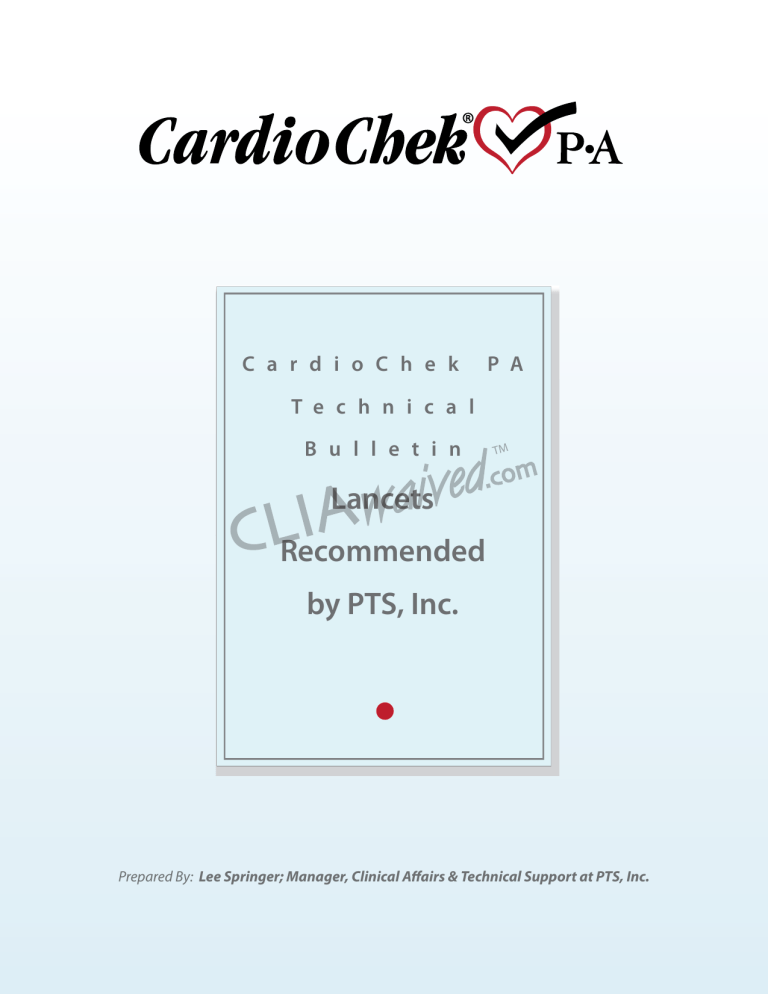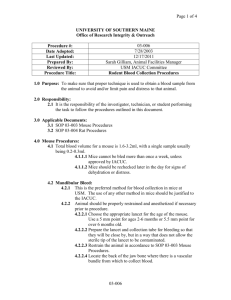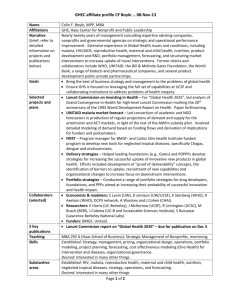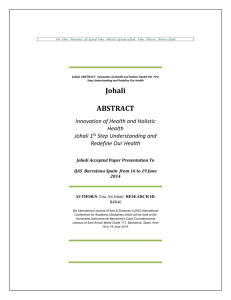Technical Bulletin

C a r d i o C h e k P A
T e c h n i c a l
B u l l e t i n
Lancets
Recommended by PTS, Inc.
Prepared By: Lee Springer; Manager, Clinical Affairs & Technical Support at PTS, Inc.
T e c h n i c a l B u l l e t i n
Lancets Recommended by PTS, Inc.
Lee Springer; Manager, Clinical Affairs & Technical Support · November 2009
Introduction
Lancing devices are used for performing skin punctures for all patient age categories. This document will highlight the basic characteristics associated with lancing devices as well as a list of recommended lancet types appropriate for specimen collection for testing on the CardioChek PA device. These devices are used in various health care and home care settings by both medical professionals and individuals for home testing purposes. The main purpose of a lancet is to puncture a person’s skin, safely and effectively enough to produce adequate blood flow. Lancing devices vary in terms of purpose, type, gauge and depth. Each of these aspects is relative to the amount of blood flow the device will yield. In order for a lancet to even create blood flow it must puncture the dermis of the skin to at least a depth of 0.6-1.3mm.
This depth is dependent on physiological variations in skin thickness and circulation of an individual. As a result, the lancet type and characteristics can have a significant impact on blood flow and the quality of results obtained from the CardioChek PA device.
Characteristics
Lancet devices, as mentioned previously, can vary greatly in their ability to cut or penetrate the skin and can produce varying degrees of blood flow rates. All lancets are intended and designed to be single-use puncture devices with many manufacturers incorporating safety devices and functions to ensure this aspect in order to prevent exposure to blood borne pathogens. It is highly recommended that single use safety lancets be used for patient care to ensure not only the patient’s safety but the safety of testing personnel as well. The design characteristics of the lancet tip – size, shape and sharpness – are directly related to the performance of the device. Derived from these characteristics are three features of the lancet which determine the purpose and blood flow rate of the lancet device.
• Gauge or Size : This measurement is different, depending on the type of the device. For needle-type puncturing devices, this is expressed in “gauge”; i.e., 21G. Lower gauge numbers mean a larger diameter of the lancet puncture device. For blade devices the size is measured
in millimeters, i.e. 2.0mm.
• Angle of Lancet : This represents the sharpness of the lancet. Smaller angles generally mean sharper lancets. It may be necessary to consult manufacturer specifications for this information.
• Penetration Depth : This is determined by the length of needle or blade in relation to penetration of the skin and is measured in millimeters.
There are two general types of lancets:
Needle Lancet : A solid tri-beveled rod similar to a standard medical syringe needle.
Blade Lancet: A small blade design which creates an incision versus a puncture.
1
T e c h n i c a l B u l l e t i n
Effectiveness
A lancing device must be capable of producing sufficient blood flow necessary to properly perform testing on a PTS Panels® panel test strip. Obtaining an adequate blood sample will depend on the lancet, the technique of the individual, physiology of patient’s skin and perfusion at the puncture site.
In addition, the effectiveness of the lancet device can also influence the overall quality of the sample collected. An inadequate lancet could result in significant specimen dilution or extensive damage to red blood cells resulting in a hemolyzed sample; in both instances the results of the test could be dramatically affected.
PTS, Inc. Recommended Lancets
Lancet Name Depth Gauge/Size
Surgilance™ Safety Lancet 2.4 mm and 2.8 mm 21 G
BD Genie™ Safety Lancet
Unistick® 3
Roche Safe-T-Pro® Plus
Bio-One VACUETTE® Safety Lancet
Vital Care Auto Safety Lancet
2.0 mm
2.0 mm
2.3 mm (adj. setting)
1.5 mm
21 G
23 G
1.5 mm 2.0 mm
2.4 mm and 3.0 mm
Vitrex® Safe Safety Lancet (MEDLANCE®)
ITC Tenderlett®
1.0 mm (blade) and
2.4 mm (needle)
1.75 mm
* Yellow highlighted area is PTS, Inc.’s preferred choice in single-use lancet technology.
21 G
1.5 mm (blade) and
21 G (needle)
0.94 mm
Conclusion
The above table represents only a small portion of lancet systems that will produce sufficient blood flow to perform testing on the CardioChek PA device. It is never safe to assume that based on the gauge and depth that the lancet will produce adequate blood flow. Always consult lancet manufacturer’s specifications to determine blood flow rates. This is due to not just the depth and penetration determining blood flow volume, but angle of lancet as well.
2
T e c h n i c a l B u l l e t i n
References
1. Diabetes Health (1994). Don’t get stuck with the wrong lancet: A lancet comparison article. Retrieved
October 20, 2009, from www.diabeteshealth.com.
2. National Committee for Clinical Laboratory Standards (NCCLS). Procedures for the collection of
diagnostic blood specimens by skin puncture, second edition. NCCLS publication H4-A2.
Villanova (PA): NCCLS, 1986.
3. New York State Department of Health (NYSDH). Blood lead and erythrocyte protoporphyrin: a
recommended procedure for collecting fingerstick blood specimens. Albany (NY): NYSDH, Wadsworth
Center for Laboratories and Research, 1989.
4. Massachusetts Department of Public Health. Procedure for obtaining fingerstick blood samples.
Jamaica Plain (MA): MDPH, Childhood Lead Poisoning Program, 1990.
3
©2009 Polymer Technology Systems, Inc.
TB000013 Rev.0 10/09
Polymer Technology Systems, Inc.
7736 Zionsville Road
Indianapolis, IN 46268 USA
+1.877.870.5610 ( Toll-free inside US)
+1.317.870.5610 (Direct ) www.
cardiochekpa
.com
CardioChek ® , PTS Panels ® , and MEMo Chip ® are trademarks
of PTS, Inc. in the U.S. and other countries.
Suggested Product Storage Conditions
CardioChek
®
products are designed to be conveniently stored at room temperature. These storage conditions and meter operating ranges are stated in the respective package insert as shown in the table below, (Column A)
It is well established that chemistry based IVDD products are best maintained at controlled room temperature which is 20-26 ° C. This controlled range helps to maintain long term product stability. In addition, avoidance of extreme temperatures during operation of the meter is preferred, thus within the range 20-27 ° C which is up to 80 ° F. These values are shown in
Column B
A B
Acceptable Conditions
1
Strip Storage Meter Operating
Range
20-30 ° C 18-35 ° C
68-86 ° F 64-95 ° F
1
See respective package insert
Strip Storage Meter Operating
20-26 ° C
68-79 ° F
Range
20-27
68-80
°
°
C
F
Current operating and storage specifications consider the broad application of our products in various health care settings. The acceptable ranges may continue to be used for all products and will yield reliable and accurate results which meet performance claims. The recommended optimal operating and storage temperatures listed in column B provide added assurance of performance reliability and long term product stability.
It is our constant mission at Polymer Technology Systems to ensure that our customers and their patients receive the most reliable and accurate results possible. In doing so, we have determined the defined new optimal operating and storage temperature ranges.
Temperature Correction Bulletin








